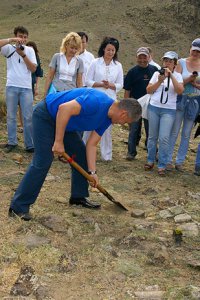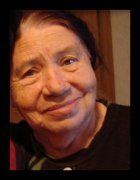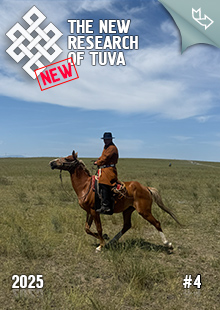 First-hand about the "Kyzyl - Kuragino" expedition. Minister of Emergencies and President of Russian Geographic Society tells us how to get into an archeological expedition, shares his memories of his past in the field, and offers advice to neophytes.
First-hand about the "Kyzyl - Kuragino" expedition. Minister of Emergencies and President of Russian Geographic Society tells us how to get into an archeological expedition, shares his memories of his past in the field, and offers advice to neophytes.
- Why was this place in Tuva in particular chosen for excavations? Why has everything been calculated for four years?
- There are three combined reasons. First - vital necessity, because this is where the "kyzyl - Kuragino" railroad will be constructed. All the expert evaluations have been done already, the project is ready, and the construction should begin soon. According to all the rules and laws, both ours and international ones, until the entire route is studied from the point of view of archeology and history, until all the archeological and historical monuments are discovered, studied or preserved for later times, the construction in that area can't begin. Second - the sheer volume. The volume is huge, and it is impossible to get all of it done in one year, otherwise we lose the quality, and won't be able to study everything thoroughly. In four years, we would like to leave a good record both in the railroad construction and in the history of Krasnoyarsk Krai, Khakassia and Tuva.
- Would there be archeological works going on in Kuragino if it weren't for the railroad?
- Hardly. A special program is needed for that. There are very many potential archeological sites on Russian territory, which could be studied, but a special permit is necessary. In this case it is a necessary measure, it is really needed, because the construction has to begin. But, I think, Russian Geographic Society still has a lot of historical - geographical work to do.
- On one hand, you are forced to do it because of the railroad construction. But on the other hand - it is a unique stratum of history, new facts are constantly being discovered. So it is a unique place?
- It is unique because this is where many nomadic routes crossed, and many nations lived there - Huns, Scythians, Uighurs, Kyrgyz. Many different historical events at various times took place there. I believe - and possibly this is just my subjective opinion - that it is one of the most interesting locations in terms of history, archeology and historical geography.
- Was the digging hard at first?
- No, why should it. It is the soil. But it is necessary to keep changing the instruments! A shovel is not mandatory - you can use a hoe or a pickaxe.
- You have participated in expeditions yourself, so you understand that for kids in expeditions things are not just interesting, but also complicated. What was the most complicated and interesting for you when you were young?
- The most complicated part was that it was the beginning of independent life. There was nobody to depend on - there was no Mama or Papa right next to me. So I learned to wrap foot cloths, and how to build tents - not for a day, but for months. Life is not easy in field conditions. Later everything becomes habitual, and you don't notice the complications anymore. And then another life begins. Interesting life.
There is much in expeditions that is absorbing - romanticism, new friends, new knowledge, new skills. It was during expeditions that I learned to ride bareback, and to ride a camel, which was also fun. But, of course, the main thing was toughening up for life. Friends that you make during times like these are like army friends - they stay friends for life.
It is possible that I began to understand only later in life that everything I saw back then, all the beauty, the monuments, which were discovered and studied then, are now on the bottom of a water reservoir. We did not have to work long during the day. The range of temperatures there is 100 degrees centigrade: -50 in winter, +50 in the summer. It is possible to work in the morning until lunchtime, but not later. Of course, it was a school of life. It was not a Young pioneer camp. We had to prepare wood for cooking fire. On some days we decided who was to be on duty, and he cooked whatever he could make. If you don't cook, your colleagues will have nothing to eat. One had to use imagination…That is where I learned to make biscuits, to boil; and roast meat and fish. Everybody brought in something of his own.
- And weren't you frightened? After all, you were digging in burials!
- Oh, come on! In expeditions, there is a completely different attitude to it. You already know who is being dug up, what depth the burial will be at, what type of burial - either like a stone house, composed of flagstones and covered with a flagstone on top, or - when they put everything in a pile and burnt it, and you have to simply go over the entire area with a shovel held short-handled, and get all the arrows, quivers, sabers, daggers, buttons, pendants and all things like this.
Two things were dangerous. First. The Huns, for example, would have a lot of stones piled up on top. You begin to take the pile apart, and there is a bunch of wasp nests. And you don't notice, grab it, disturb them, and a huge swarm of wasps attacks the entire team. The salvation is to run into water and hide there. Yenisei is too far, there is only a tiny stream nearby, coming from a glacier or a snow-cap, and it is ice-cold. The second - snakes, and there are plenty of them there. They hide out in the kurgans, but, as a rule, would run away as the work started. And that is about all that is dangerous. The rest of it is survivable - calluses, sunburn.
- I remember that you talked about a unique three-layer burial. Three levels - three totally different strata.
- The deepest of the burials was at first identified as Scythian. But there was a Hun buried on top of the Scythian, using the same material - apparently the guys were lazy, they did not feel like dragging in stones from all around. And then Red Partisans or the Red Army, who were fighting there, took a look, thought a bit - why dig a new hole when everything is ready - took off the stones and buried a Red Army soldier.
So that is how it worked out: Scythian, Hun, and a Red Army soldier.
- For students today, this expedition is a unique way of personally participating in history.
- When life offers you a chance like this, it is impossible not to take it. There will always be time to go to Dubai or to Anatolia. But to be here is a totally different thing.
When we worked, our expedition did not get any mail. Naturally, when the head of the team came, you would write letters to somebody or a telegram and would ask him to mail it. And you never knew if it would be mailed in five days or in two weeks. And things such as e-mail, sms, of course there was nothing like that. Back then, the main source of information was the radio. We especially liked to search for broadcasts evenings and at night. We felt like we were in touch with the whole world!
- It is much more difficult to get on an expedition like this than to go to a pioneer camp. There, the parents pay, and the kid goes. But how does one get here?
- Here, it is a contest, and an international one. We need enthusiastic people, such that want and can live in a group, far from home and from hot water, people who really want to learn something not known before and to get immersed in history. A huge number of students is needed - 600 people. It is a huge number, because we need 600 interested kids, willing to take risks, with fire in their eyes, looking for adventure - we have to search for them, select them, and "we have them", as they say in Odessa, we have enough, plenty of them.
Of course, I would like to go back, to work with the expedition again even in an early stage, just to demonstrate how one has to live in field conditions, so that nobody would put a snake into your sleeping bag, and that all kinds of critters would not bother you, and how to chase mosquitoes out of your tent.
I was just thinking - there is no simple and comprehensible advice about how to live in field conditions. Nobody tells you that the tent has to have a rigid frame, and that the floor of the tent must not be weighted with stones - something could crawl inside. On the contrary, every day the floors have to be raised and the tent aired. And the floor of a tent where you are planning to live for a week - and we lived there for three months, have to be covered with reeds, and you have to make small brooms from bush branches and sweep every day. Life is like that: if you don’t know how to do something and don't learn, you will have big problems - lice, boils, stomach problems.
- We hope that next year you will give a workshop for the students.
- Definitely. Field life - I would like to go back to it!
The discussion was conducted by Anastasia Chernobrovina on behalf of Russian Geographic Society and TV Channel "My planet".
 Today, on 12 November 2011, Sergei Kuzhugetovich's mother, Alexandra Yakovlevna Shoigu, died…
Today, on 12 November 2011, Sergei Kuzhugetovich's mother, Alexandra Yakovlevna Shoigu, died…
The Editors of journal "The New Research of Tuva" would like to express sincere condolences to the family and close ones.
A. Ya. Shoigu will be buried on 14 November 2011 at Troyekurovskoye Cemetery in Moscow, where her husband, Kuzhuget Sergeyevich Shoigu, has already been resting for about one year.
Because of this, the RGO presentation of "Black and White Tuva" album at the National Museum of Tuva, and meeting with S. K. Shoigu with students of Tuvan State University, planned for 14 November, will be rescheduled.

